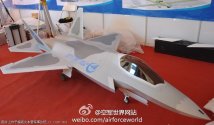You are using an out of date browser. It may not display this or other websites correctly.
You should upgrade or use an alternative browser.
You should upgrade or use an alternative browser.
Mystery aircraft 4th August 2025: CCA vs other
- Thread starter Deino
- Start date
F-60 is the original FC-31, it was just called a different name originally. It was 17.3*11.5m in dimension which as a reference is bigger than the F-35A/B model but slightly smaller in terms of wingspan compared to C model but still ~2m longer. So, it's a pretty standard sized medium weight fighter aircraft. Anything larger would probably be in the range of heavy fighters like F-22/J-20/Su-57 and beyond.How big was the F-60 model? I am strictly referring to it, not the FC-31/J-35 fighter.
I was referring to the scale model F-60, not the full scale FC-31 aircraft. Maybe that is what Guancha is saying, it's much bigger than the F-60 model, but in relative terms it would still be a fairly small aircraft, likely unmanned/RC controlled. Just like for instance the X-36 was quite small.
View attachment 157513
I don't think the F-60 model every flew, as far as I know, so comparing it to the F-60 model would be a bit odd.
I've just listened to the podcast, the trio seems convinced that this is related to the Northwestern Polytechnical University project/patent and said something about a flying F-60 model(?). Maybe someone more fluent can listen to the podcast and tell us what they are implying.
Well, after listening to Yankee and Shilao spend a significant portion of yesterday's podcast diving into the history of self-developed testbeds from Chinese universities and research institutes, I think the picture is pretty clear now: this is a research project test aircraft. As for what might eventually spin off from this program—well, that’s a conversation for another time.
This is likely just an aerodynamic testbed—no need to validate complex onboard systems. And regarding funding, it’s true that university budgets alone couldn’t cover this. But if it’s a government/military-backed research project (like HPPSARP, for example), then the whole thing starts making sense.
Thanks a lot for the summary even if - at least for me - this explanation opens up more questions than it answers ...
1. I agree, testbeds from Chinese universities and research institutes are real and likely, but usually sub-scale and not full-sized or even larger than other regular aircarft from regular manufacors.
2. Universities and research institutes don't have manufacturing facilities, at best a small workshop but not a site capable to assemble a full-scale aircraft of a size of the J-36/J-XDS! So if it is a testbed from a university or research institute a regular company like CAC/SAC/XAC must be allocated or at least assist the assembly ... but which one in that case?
3. Cost: a sub-scale testbed is affordable but a full-sized aircraft of that size needs a budget and a team big enough and IMO far beyond what regular universities and research institutes can afford, even if state-founded!
On the topic of manufacturing facilities, Yankee brought up an interesting example: Apparently, Chinese aircraft manufacturers often "borrow" university research teams to assist with development (referred to as "outsourced collaboration"). Professors are eager to join these projects since it boosts their career advancement.2. Universities and research institutes don't have manufacturing facilities, at best a small workshop but not a site capable to assemble a full-scale aircraft of a size of the J-36/J-XDS! So if it is a testbed from a university or research institute a regular company like CAC/SAC/XAC must be allocated or at least assist the assembly ... but which one in that case?
Yankee mentioned that in some factories, you might find an entire workshop packed with teams from a single university—so much so that the workshop gradually becomes a de facto "university-affiliated factory." He even joked that China’s own Skunk Works might emerge from one of these setups.
On the topic of manufacturing facilities, Yankee brought up an interesting example: Apparently, Chinese aircraft manufacturers often "borrow" university research teams to assist with development (referred to as "outsourced collaboration"). Professors are eager to join these projects since it boosts their career advancement.
Yankee mentioned that in some factories, you might find an entire workshop packed with teams from a single university—so much so that the workshop gradually becomes a de facto "university-affiliated factory." He even joked that China’s own Skunk Works might emerge from one of these setups.
In fact a most logical development ... however the question remains, which company/manufactor is responsible for the manufacturing/assembly of the new one seen? No idea given by the trio?
Not at all,they only hinted at a possible connection between that delta-shaped and NPU’s patent.Honestly, under these circumstances, I don’t think where the prototype was manufactured is all that important.In fact a most logical development ... however the question remains, which company/manufactor is responsible for the manufacturing/assembly of the new one seen? No idea given by the trio?
They've hinted that this aircraft might just be a university's experimental project and probably won't go into mass production. Back during China's earlier development stages when resources were tighter, the country needed to pool resources into flagship research programs. That's why most aircraft models revealed back then ended up being mass-produced. But now that China has greater resources, many universities and institutions are pursuing all kinds of experimental projects—plenty not even aimed at mass production. They're asking everyone to temper expectations and not get too hyped up about this particular aircraft.I've just listened to the podcast, the trio seems convinced that this is related to the Northwestern Polytechnical University project/patent and said something about a flying F-60 model(?). Maybe someone more fluent can listen to the podcast and tell us what they are implying.

